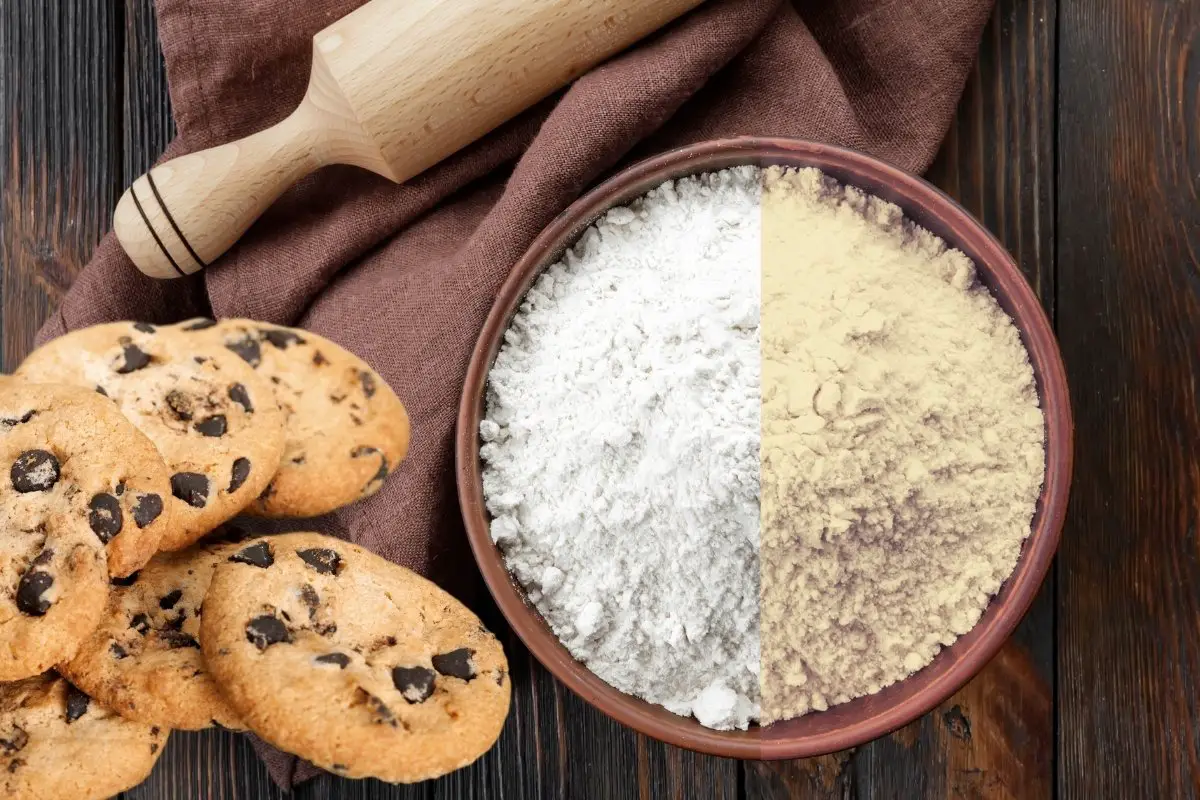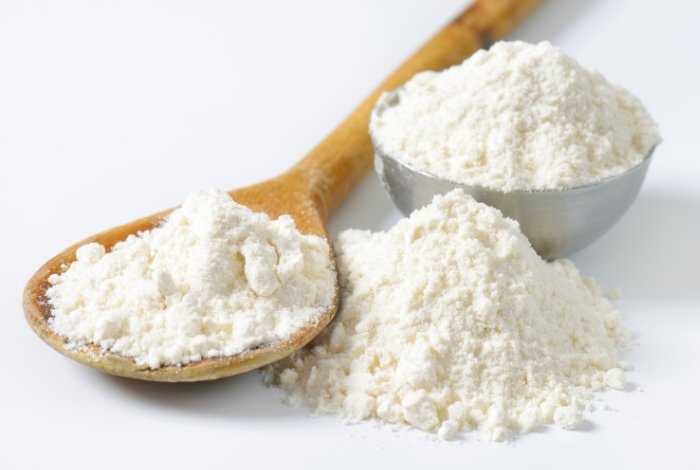Last Updated on February 7, 2023
When it comes to cookies, flour is one of the most important ingredients. However, you may have wondered, can you use unbleached flour for cookies?
Flour plays an important role in the texture and flavor of cookies. It is an important ingredient that you can’t leave out, as it would ruin your cookies. It gives cookies a lovely chewy, crispy, or crunchy flavor, depending on the ratio to the other ingredients.
Before establishing whether can you use unbleached flour for cookies, it is vital to learn the difference between bleached vs unbleached flour.
Unbleached Vs Bleached Flour: Can You Use Unbleached Flour for Cookies?
As an important pantry staple, you probably have a bag of all-purpose flour in your kitchen. All-purpose comes in both bleached and unbleached. You might have wondered which option is the best one to buy for your needs.
Bleached and unbleached flour varies in different ways such as processing, taste, texture, and appearance. Technically, all flour is bleached, but it is the process of how it is done that sets them apart. Each of them has its benefits, as they work differently in different recipes.
Bleached and unbleached flour has nearly identical nutritional values. They contain the same calories, carbs, fat, protein, and fiber. Both kinds of flours are generally enriched with folate, niacin, vitamin B6, and thiamine.
Unbleached Flour
Unbleached flour is bleached naturally as it ages over time after it has been milled. It is off-white, and it dulls as it continues to age. Unbleached flour also has a denser grain than bleached flour.
Unbleached flour ages by being exposed to oxygen over time. It often has no, or very few, additives mixed into it.
Bleached Flour
Bleached flour tends to be more common than unbleached flour. It uses bleaching agents such as benzoyl peroxide and chlorine gas to speed up its aging process. Due to the bleaching agents, bleached flour is whiter in color and is a finer grain.
In addition, bleached flour has a softer texture than unbleached flour. Foods made with bleached flour are soft, with more volume, and have a brighter color than foods made from unbleached flour. Bleached flour is typically used for baking cookies, quick bread, pancakes, muffins, and pie crusts.
Key Differences of Bleached Flour vs Unbleached Flour
- Bleached flour has a finer, softer texture and unbleached flour has a denser grain and slightly tougher texture.
- Bleached flour is whiter in color than bleached flour.
- Bleached flour works better for cookies, pancakes, waffles, cakes, quick bread, and pie crusts. Unbleached flour works better for puff pastries, eclairs, yeast bread, and popovers.
- Bleached flour is treated with chemicals to speed up the aging process and unbleached flour is naturally aged after milling.
Can You Use Unbleached Flour for Cookies?
Many people opt to use bleached flour for making cookies. Since it has a finer texture and absorbs more liquid, it is a good choice for cookies. It also gives cookies a soft, chewy texture.
However, you can use unbleached flour when making cookies. The results will likely be similar though your cookies may not be quite as soft.
In addition, bleached flour is cheaper and generally more readily available than unbleached flour. However, since both have a medium level of protein they can be used to make cookies. Both kinds of all-purpose flours will result in delicious cookies, so it is alright to use them interchangeably if desired.
Check out these Delicious Recipes:
The Best Flour for Chocolate Chip Cookies
The best flour to use for chocolate chip cookies is all-purpose flour. You can use either unbleached or bleached all-purpose flour to make your cookies. However, many people do prefer to use bleached flour when it comes to making cookies.
Thanks to the finer texture of bleached all-purpose flour, it tends to provide a better texture to your cookies. Bleached flour tends to create softer baked goods, creating an overall better cookie. However, some people prefer unbleached flour for their chocolate chip cookie recipes.
While you can use other types of flour to make chocolate chip cookies, you should expect different results. All-purpose flour will give your cookies the soft, chewy texture that they are famous for.
Most cookie types will call for all-purpose flour in the recipe. All-purpose flour provides the best structure for most types of cookies thanks to its ability to create chewy and soft cookies.
Some of the most popular types of cookies to call for all-purpose flour in the recipe include chocolate chip, sugar, peanut butter cookies, shortbread, gingerbread, and snickerdoodles. Other varieties include crinkle cookies, spritz cookies, butter cookies, pinwheel cookies, oatmeal raisins, and gingersnaps.
Cake Flour vs All-Purpose Flour for Cookies
Cake flour can also be used to make cookies as well. Cake flour has a lower protein content than all-purpose flour, at about 7% to 9% protein compared to 10% to 12%.
With cake flour, cookies will have a softer, fluffier, more delicate texture than cookies made with all-purpose flour. When you use cake flour for cookies, your cookies will have a more cake-like texture rather than a chewier texture.
Some people will bake cookies with a mixture of 50% cake flour and 50% all-purpose flour. This will create a delicate cookie with a light inside and slightly crispy edges that still has some of the chewy texture you would get with just all-purpose flour.
Can You Use Whole Wheat Flour for Cookies?
You can use whole wheat flour for cookies, however, the results will differ. Depending on the recipes, you may barely notice a change, but in most cases, there will be a slight difference in flavor and texture.
Whole wheat flour is not as fine as bleached all-purpose flour, so the cookies won’t be as soft. You may even notice a slightly “grainer” texture with cookies made with whole wheat flour compared to those with all-purpose. For a good balance, you can use a mixture of 50% whole wheat flour and 50% all-purpose flour.
The Best Way to Measure Flour
No matter if you decide to use bleached or unbleached flour, it is important to properly measure your flour. Too much flour and your cookies will be thick and tasteless. Too little flour and your cookies will not stay together.
When measuring flour for cookies, it can be tempting to simply use the measuring cup to scoop the flour out of the bag. However, this can result in up to 30% more flour than the recipe calls for. As a result, this will affect the taste and texture of your recipe.
Etekcity Food Kitchen Scale, Digital Grams and Ounces for Baking, Cooking
The best way to measure flour is by using a kitchen scale. This will give you the most accurate measurement of your flour, ensuring your cookies turn out tasty. It is an easy and effective way to measure it.
If you don’t have a kitchen scale, the next best way to measure out your flour is by using a spoon and knife. Simply scoop the flour into the measuring cup by using a spoon. Once it is full, use a knife to level it off, making sure you don’t pack it down and get too much flour.
Deciding Which Flour is Best to Use in Your Cookie Recipe: Can You Use Unbleached Flour for Cookies?
Most people will opt to use bleached flour when baking cookies. It is cheaper and softer in grain, which makes for a delicious cookie. However, you can also use bleached flour in your recipe, as you likely won’t be able to tell a difference between the two types.
Do you have any questions about using bleached or unbleached flour for cookies? If so, please ask your questions in the comments down below.

Ever since she was a young girl, Anna has been a lover of desserts. As an adult, she enjoys
baking a variety of desserts from cakes, cookies, brownies, bread, and more from scratch. She
enjoys sharing her passion for baking with others who also have a sweet tooth. From properly
measuring ingredients to making sure they are the correct temperature, Anna knows the
importance small details can make in baking. She wants to share her experience with others in
hopes they can make the most delicious baked goods. When she’s not busy blogging, Anna
enjoys trying new recipes in the kitchen.



